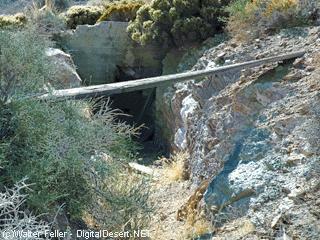Chloride Cliff
Given the poor records which have survived from these early days of mining, we have no estimate of production from the mine. The papers mentioned several times that pack mules were bringing out ore, but nothing more definite can be stated. But Franklin and his mine had a decided effect upon the future history of Death Valley. The wagon road blazed by his suppliers was used and improved by the large borax teams in later years, and Franklin had proved that there was ore in the Funeral Mountains. Thirty years later, when the Nevada mining boom began at Tonopah and Goldfield, prospectors remembered the old Chloride Cliff Mine, and came back to have another look at the area.
Franklin, in the meantime, did, not abandon his mine. Every year, he traveled back across the desert to perform the annual assessment work on the Chloride Cliff Mine, until his death in 1904. Then his son, George E. Franklin, followed in his footsteps, and kept the claim active via the required assessment work. Thus when the Bullfrog boom hit southwest Nevada, the younger Franklin held an active and valid claim, which could once more be profitable as transportation and supplies became cheaper through connections at the new boom town of Rhyolite.
With the exception of the Franklins, the Chloride Cliff area was virtually deserted between 1873 and 1903, when the Keane Wonder Mine was located about two miles to the southwest of Chloride Cliff. Then, in 1904 the Original Bullfrog Mine was discovered, and the great Bullfrog boom was on. As the ground around the Bullfrog Hills was soon covered with locations, prospectors gradually spread farther afield and their attentions were naturally drawn rather quickly to the Chloride Cliff area. This region, after all, had already produced two mines, the Franklin Mine in 1873 and the Keane Wonder in 1903.
George Franklin was on the scene, and the new excitements caused by the Keane Wonder and the Bullfrog boom made him redouble his efforts on the old Chloride Cliff Mine. In the meantime, numerous other mining companies were appearing, as locations were made, bought and sold, and consolidated. The area around Chloride Cliff, from Daylight Springs in the north to Furnace Creek in the south, and from Death Valley on the west to the Amargosa Valley on the east, was swarming with prospectors, and in September of 1905 the South Bullfrog Mining District was formed. The old Chloride Cliff Mine, which was now commonly called the Franklin Mine, was included in the new district.
< Previous
Next >


